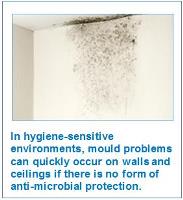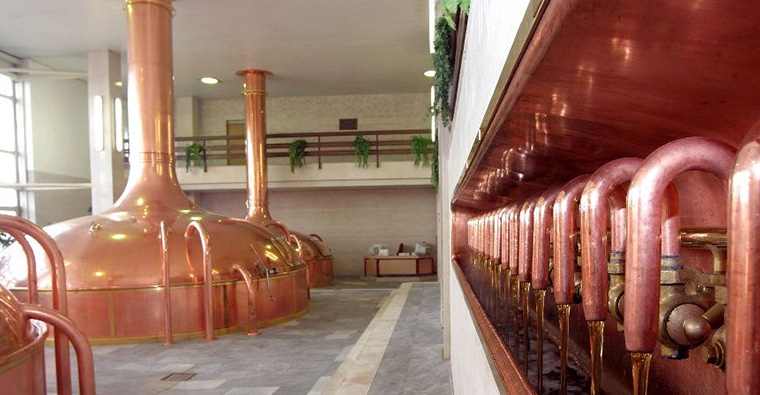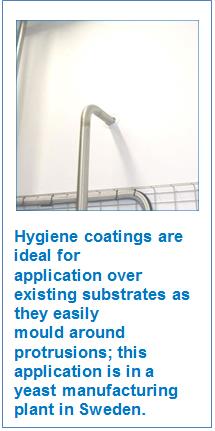Introduction of Hygiene Coatings
A hygiene coating system is, in effect, a multi-functional new surface applied to a building substrate. In industrial applications, hygiene coatings need to meet key criteria – they must be protective yet decorative, they must be ideal for use in a range of environments on various substrates and they must be independently tested and certified to confirm that they are safe to use and apply in sterile areas. Crucially, they must not contaminate the environment in which they are applied and the coatings must protect themselves from micro-organisms whilst neutralising them in a way which will not allow resistance to develop.
The Industries and Their Needs
On the internal walls and ceilings of industrial environments – such as food manufacturing plants, pharmaceutical manufacturing, hospitals and leisure facilities – it is essential that micro-organisms do not proliferate, as they could otherwise contaminate foodstuffs, pharma products and the local environment and lead to adverse health effects.
The infrastructure being coated may be a new build or refurbishment project and the demands of a hygiene coating will vary depending on the environment. The substrate could be damp and the chosen coating must thus allow for moisture vapour release, it must afford excellent adhesion and be able to be steam cleaned daily; it must remain resistant to chemicals and provide a seamless, film-protected environment with no hiding place for organic matter.
To ensure this, the coating must be applied as part of a system approach. Old substrates will invariably be contaminated with bacteria and require sterilisation before a hygiene system is applied. The coating may also need to be reinforced to resist impact damage and it is important that a fully seamless system is achieved over joints and cracks. A hygiene coating system must not allow sympathetic cracking as this would be an area in which dirt would gather.
The coating also needs to be high build in composition to allow the incorporation of local or overall reinforcement systems. Some reinforcements such as glass-fibre ‘wallpapers’ have decorative properties and once set into the coatings are very durable.
high build in composition to allow the incorporation of local or overall reinforcement systems. Some reinforcements such as glass-fibre ‘wallpapers’ have decorative properties and once set into the coatings are very durable.
Industrial specifiers need the assurance of long-term protection against micro-organisms and often seek 10-year guarantees. Depending upon the environment in which the coatings are applied, the specifier will be seeking protection against specific strains of mould, bacteria or yeasts. For example, in hospital environments specifiers will be seeking coatings that combat against hospital-acquired infections (HAI’s) such as Methicillin Resistant Staphylococcus Aureus (MRSA) and for pharmaceutical clean room applications, specifiers will be seeking a surface finish that does not attract or retain dust. In all s uch applications, the coatings must also be non-leaching, so biocides incorporated into the coatings must not leach to the surface.
uch applications, the coatings must also be non-leaching, so biocides incorporated into the coatings must not leach to the surface.
Lastly, due to the nature of industrial environments which are often ‘in process’ 24 hours, seven days a week, the downtime when coatings are applied must be minimal. Waterborne systems offer significant advantages over solvent-based systems as they can be applied and allow continuation of processes within 24-48 hours.
Areas Where Hygienic Coatings are Used:
These typically include:
- Food and drink manufacturing: meat and vegetable processing, breweries, bakeries, dairies, abattoirs
- Pharmaceutical: clean rooms, wet process areas
- Medical: hospitals, laboratories
- Leisure: swimming pools, shower and changing areas
Each sector will have specific demands. For example, breweries will be concerned that no yeast growths proliferate to contaminate the yeasts in use during the brewing process.
Legislative Demands
Various industries will have in-house demands from their own hygienists and environmental managers. Another key driver is that of legislative demands and furthermore, foodstuffs from less developed countries are increasingly subject to scrutiny from importers, often supermarket giants. Here there is a recognition that all sources should be at the same standard even without national legislation.
When considering what legislation prevails at a given time, we enter the field for experts. In the UK, the law currently dictates that the layout, design and construction of premises shall:
- Allow staff to clean and disinfect the premises easily
- Protect against the build-up of dirt, toxic materials, prevent dirt getting into food and inhibit mould growth on surface and reduce condensation effects
- Allow good hygiene practices to take place
Walls, ceilings and other surfaces should be made of materials that can be cleaned easily, and, where necessary, disinfected. This outlines the basic requirements for hygiene in premises where food is processed or stored. The USA has its own requirement under the umbrella of the Food and Drug Administration (FDA). More specifically, the US Department of Agriculture (USDA) directs what is permitted, along with the Environmental Protection Agency (EPA). These impose restrictions on the materials permitted to afford anti-microbial protection and the claims that can be made.
If is a coating is claimed to actively ‘kill’ micro-organisms, it will not be permitted by the USDA in meat and poultry plants. It is therefore crucial that the hygiene coating manufacturer provides materials that are acceptable and limits claims to ‘film protection’ only.
Other relevant legislative issues include the Biocidal Products Regulations (BPR) which demand that any biocide or product containing a biocide, such as hygiene coatings, shall be subject to regulation. Products in use in Great Britain with specific claims, such as biocidal pre-washes, are subject to registration from the Health and Safety Executive (HSE). Finally, VOC regulations are decisive, it is highly desirable to have minimal VOC content.
Pre-Treatments, Coatings and Systems
Hygiene Coating Systems
The choice of hygiene coating is often made from relatively few criteria:
- Is it safe to use and independently certified?
- Can it be used in the given process area?
- Is it a complete package? (e.g. primers, top coats, reinforcements, etc.)
- Can it be applied by brush, roller or spray as may be convenient?
- Does the manufacturer produce materials to a recognised international quality standard? For example, Flexcrete manufactures products to BS EN ISO 9001:2008
Repair Mortars
Leading manufacturers will produce a range of hand-placed, sprayable or pourable repair mortars based on advanced cement and microsilica technology for cosmetic or structural repairs prior to the application of a hygiene coating. A single application can fill a hole up to 4” deep at any angle.
Sealants
Water-based sealants are available with excellent compatibility both above and below the hygiene coating system. They can be used around doors, window frames and skirting boards.
Biocidal Wash
These must be approved by the HSE. Leading manufacturers will offer powerful water-based surface treatment washes for neutralising active mould, fungal and bacterial growth prior to the application of a hygiene coating system.
Primers
Waterborne primers are available to ensure adhesion to the underlying substrate and to ensure that the topcoat adheres strongly. One such product is Flexcrete’s Bond-Prime – a single component, water-based, epoxy modified polymeric primer which is rapid curing, non-hazardous and enhances bond significantly.
Topcoats
Various hygiene coatings are available and the leading products on the market are low VOC, waterborne and with good water vapour transmission. They exhibit excellent adhesion to a variety of building substrates and products such as Flexcrete’s Biodex hygiene coatings incorporate both encapsulated biocide and silver ion technology to combat against the growth of a wide range of micro-organisms.
Hygiene Coatings in Comparison to Traditional Materials
Conventional Fungicidal Paints
These are designed to give a ‘quick kill’ of micro-organisms, however they leach potentially toxic chemicals, are prone to cracking and flaking and effectively become inert within 2-3 years when subjected to repeated cleaning.
Ceramic Tiles
These are hard, easy to clean and impermeable, however the grouting is the weak link as it harbours dirt and bacteria. By comparison, hygiene coatings are completely seamless.
Wall Cladding Systems
These are expensive and require specialist installation, plus they do not incorporate anti-microbial protection like hygiene coatings. Nevertheless, a hygiene coating can be applied over the top of a cladding system to afford active protection.
Microbial Problems and Hygiene Coatings
The industries defined face a multitude of microbial problems, often specific to the particular use of the building. The following is an assessment of three areas:
Food
Food poisoning can cause serious illnesses, and in severe cases can lead to permanent disability and even death. According to the Health Protection Agency there were almost 75,000 statutory notifications of food poisoning in England and Wales in 2009. This places a significant burden on the economy, costing in the region of £900 million.
Threats to humans can stem from the following bacteria: Salmonella, Clostridium, Shigella, Campylobacter, Listeria, E.coli and Staphylococcus. In 2012, an E.coli outbreak linked to a Belfast restaurant led to 25 confirmed cases and 154 suspected cases of food poisoning, said to be Northern Ireland’s worst-ever E.coli outbreak. Many will remember the world’s worst recorded outbreak of E.coli in Scotland in 1996, which led to the death of 21 people and 496 cases. Leading hygiene coatings are independently tested to confirm they prevent the growth of E.coli.
Hospitals
Hospital-acquired infections (HAI’s) are caused by a wide variety of organisms and cause a range of symptoms from minor discomfort to serious disability and in some cases death. In 2007, around 9,000 people in England were recorded as having died of MRSA. At any time, over 1.4 million people worldwide suffer from infectious complications acquired in hospital (Source: World Health Organisation). With many hospitals identified as being contaminated by these organisms and with up to six months’ survival times, it is felt that hygiene coatings which neutralise them have a significant part to play in secondary prevention roles. It may be noted that ceilings in medical environments are not usually cleaned, whilst walls are subject to less cleaning than floors. The opportunities from hygiene coatings are in HAI risk reduction and potential savings to authorities in preventing whole ward closures.
Pharmaceutical
The threat here is from the contamination of products and cultures from airborne bacteria. Equally it would be catastrophic to have any fungal or mould growth giving potential cross-contamination. In the pharmaceutical sector Salmonella SP and Pseudomonas SP are examples of spoilage micro-organisms.
Combating the Proliferation of Micro-Organisms
Given the very real problems of the major industries and of the thousands of smaller individual premises potentially at risk, what is needed from a hygiene coating to prevent proliferation and how is this achieved?
The active ingredients in leading hygiene coatings are non-leaching. By comparison, ‘quick-kill’ fungicidal paints leach out their active ingredients and diminish in their effectiveness very quickly once their active runs out. In laboratory tests hygiene coatings neutralise more slowly and eliminate growth to virtually zero proliferation.
A carefully formulated hygiene coating acts in a multi-site way to neutralise micro-organisms. The non-leaching action, operating only at surface molecular level, ensures a long life even if the hygiene coatings is worn down in thickness by the working environment and associated cleaning regimes – as fresh surface active is always available.
Substrate Considerations
So far we have seen general use areas as defined in various industries. Within each of these environments is a large variety of surfaces which can be coated. The practicality of applying the hygiene coating and what the substrate itself demands must be taken into account.
Basic building materials such as concrete, cement, plaster, brickwork and wood do not provide surfaces which are easily maintained in a hygienic condition. Cement render, for example, is not a stable substrate, but can crack and start flaking off walls causing gross contamination. The surface also tends to be friable, dusty and porous, allowing in moisture which assists mould growth. The cracks which form are also ideal sites for the build-up of dirt and fats.
Refurbishment and New Build
Constraints of time, money and the need to comply with health inspection requirements often mean refurbishment is the practical way forward. Older buildings often present cracks, joints, irregular surfaces, mixed substrates, possible dampness and existing contamination from previous processes.
New build structures can also incorporate protective coatings even if an ideal substrate is put in place. Stainless steel or easy-clean plastic surfaces are usually placed in critical areas only, leaving upper areas of walls with a conventional plaster finish requiring coating.
Similarly, ceilings may be made of inert easy-clean materials over critical process areas, but not necessarily overall. Suspended ceilings could potentially harbour growth in joints, on suspension rails or behind – all areas which can be corrected by hygienic coatings.
Substrate Preparation and System Selection
The essential requirements are to bring the substrate to a common high standard. Critical to this is preparation and should they be required, primers will be selected based on the substrate and the prevailing conditions. The choice of primer and topcoat may be dictated at times by the requirement to keep a plant running or shutdown restrictions; however the recommendation is always to select low hazard, water-based materials.
Conclusion
In meeting the key industries’ requirements, a holistic approach is needed in selecting a hygiene coating. The coating must offer a range of physical properties to perform a number of associated tasks dictated by both the substrate onto which it is applied, as well as the use environment with decorative aspects being covered by a range of matt to sheen finishes. The anti-microbial ‘film-protected’ coating must be demonstrated to be multi-site specific in its action, as safe as possible to use, and offer guaranteed long-life performance.



